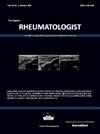Clinical expression of axial spondyloarthritis among a cohort of Egyptian patients
IF 1
Q4 RHEUMATOLOGY
引用次数: 0
Abstract
Aim of the work
To study characteristics of axial spondyloarthritis (axSpA) among Egyptian patients in relation to disease and gender related features.
Patients and methods
This study recruited 88 axSpA patients. Evaluation of demographics, clinical characteristics, laboratory tests, Bath ankylosing spondylitis disease activity index (BASDAI), Axial Spondyloarthritis Disease Activity Score (ASDAS), Bath Ankylosing Spondylitis Functional Index (BASFI), and health index (HI) was performed.
Results
Patients with axSpA showed male predominance (M: F 2.3:1), human leucocytic antigen-B27 (HLA-B27) positivity in 59.4 %, high ASDAS in 60.2 %, poor HI in 13.3 %, peripheral manifestations were mainly arthritis, and enthesitis, extra musculoskeletal manifestations were mainly anterior uveitis. Early axSpA was reported in 8 % of patients. Females displayed initial axial and peripheral symptoms (p = 0.019), more arthritis (p = 0.003), dactylitis (p < 0.001), enthesitis (p = 0.042), and family history of SpA (p = 0.022) than males, with comparable BASDAI, ASDAS, BASFI and HI. Patients with radiographic axSpA (r-axSpA) exhibited initial axial symptoms (p < 0.001), male predominance (p = 0.002), higher C-reactive protein (CRP) (p = 0.016), HI (p = 0.007) and HLA-B27 positivity (p = 0.04), while non-radiographic axSpA (nr-axSpA) patients displayed initial axial and peripheral symptoms (p < 0.001), more arthritis (p < 0.001), dactylitis (p < 0.001), enthesitis (p = 0.001), early axSpA (p = 0.001), family history of SpA (p = 0.021), with comparable BASDAI, ASDAS and BASFI.
Conclusion
Patients with r-axSpA were predominantly males, with higher CRP, HLA-B27 positivity, initial axial presentation, worse HI, less frequent arthritis, dactylitis and enthesitis, early axSpA, and family history of SpA compared to nr-axSpA. Females displayed more arthritis, dactylitis and enthesitis, initial axial and peripheral symptoms, and family history of SpA compared to males.
一组埃及患者中轴性脊柱炎的临床表现
研究埃及中轴性脊柱炎(axSpA)患者与疾病和性别相关特征的关系。患者和方法本研究招募了88例axSpA患者。对人口统计学、临床特征、实验室检查、巴斯强直性脊柱炎疾病活动性指数(BASDAI)、轴向性脊柱炎疾病活动性评分(ASDAS)、巴斯强直性脊柱炎功能指数(BASFI)和健康指数(HI)进行评估。结果axSpA患者以男性为主(M: F 2.3:1),人白细胞抗原b27 (HLA-B27)阳性占59.4%,ASDAS高占60.2%,HI差占13.3%,外周表现以关节炎为主,鼻炎、外肌骨骼表现以葡萄膜前炎为主。8%的患者报告了早期axSpA。女性表现出最初的轴和外周症状(p = 0.019),关节炎(p = 0.003)、指炎(p < 0.001)、鼻炎(p = 0.042)和SpA家族史(p = 0.022)多于男性,BASDAI、ASDAS、BASFI和HI与男性相当。x线axSpA (r-axSpA)患者表现为初始轴向症状(p < 0.001)、男性优势(p = 0.002)、较高的c反应蛋白(CRP) (p = 0.016)、HI (p = 0.007)和HLA-B27阳性(p = 0.04),而非x线axSpA (r-axSpA)患者表现为初始轴向和外周症状(p < 0.001)、较多的关节炎(p < 0.001)、趾炎(p < 0.001)、鼻炎(p = 0.001)、早期axSpA (p = 0.001)、SpA家族史(p = 0.021),与BASDAI相当。ASDAS和BASFI。结论与nr-axSpA相比,r-axSpA患者以男性为主,CRP、HLA-B27阳性、初始轴向表现较高、HI较差、关节炎、指炎、鼻炎、早期axSpA发生率较低、家族史较轻。与男性相比,女性表现出更多的关节炎、指趾炎和鼻炎、初始轴向和外周症状以及SpA家族史。
本文章由计算机程序翻译,如有差异,请以英文原文为准。
求助全文
约1分钟内获得全文
求助全文

 求助内容:
求助内容: 应助结果提醒方式:
应助结果提醒方式:


